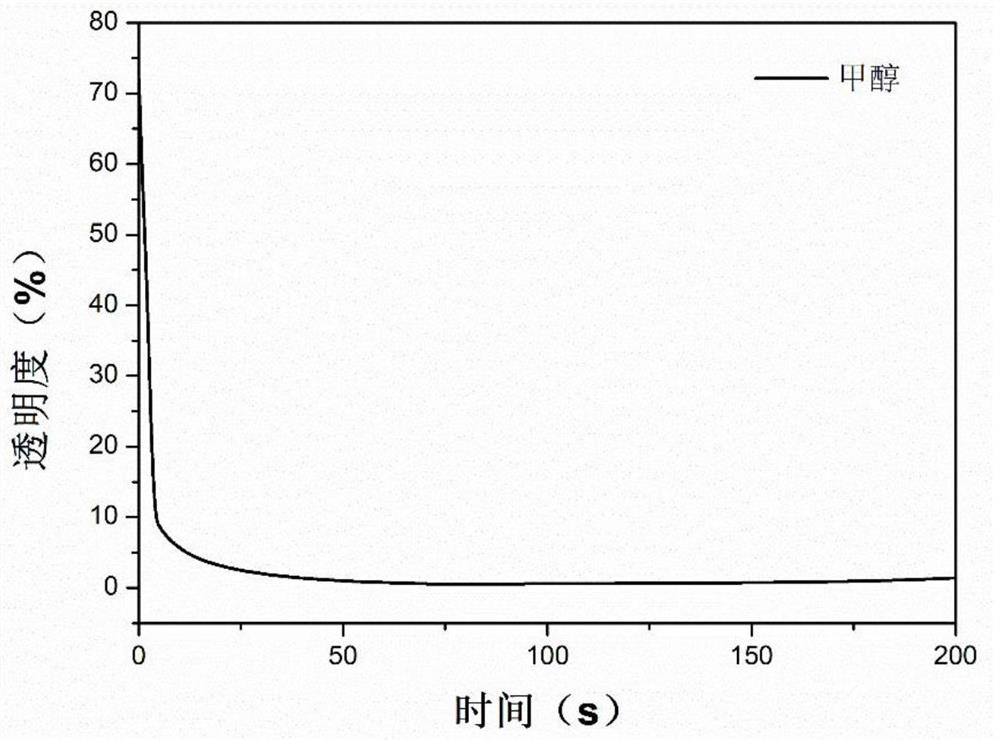Preparation method of hydrogel material with multiple stimulation responses
A multi-stimuli-responsive, hydrogel technology, applied in the field of hydrogel material preparation, can solve the problems of independent and single information recording function, inability to effectively realize the effective erasure of recorded information and multiple reusable use, and achieve biocompatibility The effect of excellent sex and mild external stimulation
- Summary
- Abstract
- Description
- Claims
- Application Information
AI Technical Summary
Problems solved by technology
Method used
Image
Examples
Embodiment 1
[0042] Embodiment 1: A method for preparing a hydrogel material responsive to multiple stimuli, the prepared hydrogel material includes the following components in parts by mass:
[0043] 80-120 parts of isopropylacrylamide (NIPAM).
[0044] Nanocellulose (CNF) 0.1-0.25 parts.
[0045] N, N-methylenebisacrylamide (BIS) 0.8-1.2 parts.
[0046] 0.8-1.2 parts of 2-hydroxy-2-methylpropiophenone (UV-initiator).
[0047] 500-1000 parts of deionized water.
[0048] Isopropylacrylamide is used after purification, and the used polymerization mold is used after deoxidizing treatment.
[0049] The purification method of isopropylacrylamide is recrystallization method, including:
[0050] S1. Put 80-120 parts of NIPAM powder in 320-480 parts of n-hexane solution and stir at 35-55°C.
[0051] S2. After the NIPAM is completely dissolved, put the mixed solution in an ice-water bath for a period of time, and immediately carry out suction filtration when turbid precipitation occurs.
[0...
Embodiment 2
[0065] S1. Weigh 0.1 part of CNF in 1000 parts of deionized water according to the proportion, stir for 8 hours, and mix well.
[0066] S2. Weigh 100 parts of NIPAM, 1 part of BIS, and 0.01 part of UV-initiator in sequence according to the proportion, add them to the mixed solution in S1, and stir in an ice bath in the dark for 30 minutes, so that the reaction solution is evenly mixed. Subsequently, the reaction solution was placed in a vacuum oven for 5 min, and the oxygen in the system was removed under a vacuum environment.
[0067] The precursor solution after deoxygenation was injected into the mold of the polymerization mold, and placed in an ice-water bath, and the prepared multi-stimuli-responsive hydrogel material was obtained by ultraviolet polymerization for 1 hour, and the turbidity was obtained by differential scanning calorimetry. The critical phase transition temperature (LCST) of the region.
Embodiment 3
[0069] S1. Weigh 0.15 parts of CNF in 1000 parts of deionized water according to the proportion and stir for 8 hours, and mix well.
[0070] S2. Weigh 100 parts of NIPAM, 1 part of BIS, and 0.01 part of UV-initiator in sequence according to the proportion, add them to the mixed solution in S1, and stir in an ice bath in the dark for 30 minutes, so that the reaction solution is evenly mixed. Subsequently, the reaction solution was placed in a vacuum oven for 5 min, and the oxygen in the system was removed under a vacuum environment.
[0071] The precursor solution after deoxygenation was injected into the mold of the polymerization mold and placed in an ice-water bath, and the prepared multi-stimuli-responsive hydrogel material was obtained by ultraviolet polymerization for 1 hour. The critical phase transition temperature (LCST) of the turbid region was obtained by differential scanning calorimetry.
PUM
 Login to View More
Login to View More Abstract
Description
Claims
Application Information
 Login to View More
Login to View More - R&D
- Intellectual Property
- Life Sciences
- Materials
- Tech Scout
- Unparalleled Data Quality
- Higher Quality Content
- 60% Fewer Hallucinations
Browse by: Latest US Patents, China's latest patents, Technical Efficacy Thesaurus, Application Domain, Technology Topic, Popular Technical Reports.
© 2025 PatSnap. All rights reserved.Legal|Privacy policy|Modern Slavery Act Transparency Statement|Sitemap|About US| Contact US: help@patsnap.com



